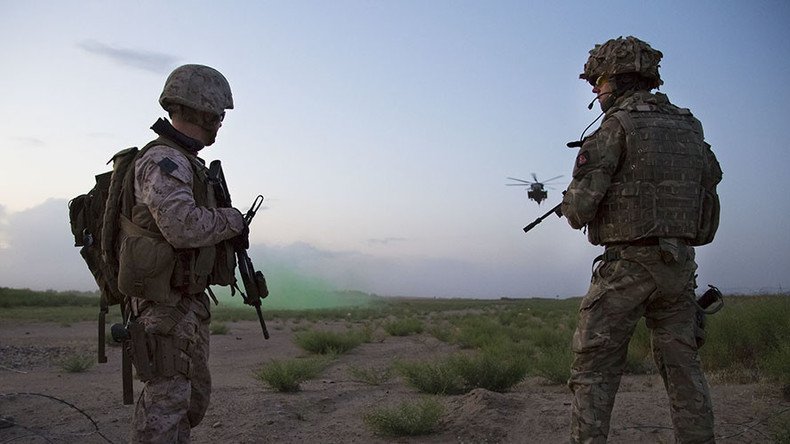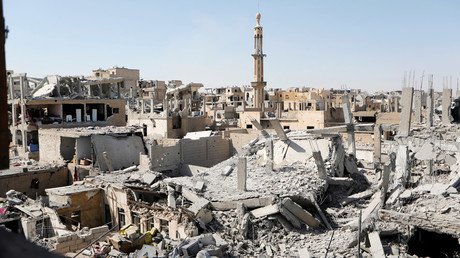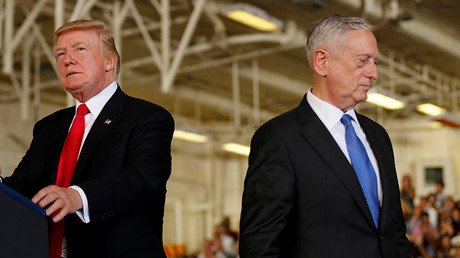With Afghanistan surge, Trump has completely surrendered to the neocons

This week, US President Donald Trump announced that he would commit more American troops to Afghanistan. The irony is, not even Trump himself thinks this is a real solution to the Afghanistan quagmire.
Between October 2011 and November 2013, Trump tweeted no less than 13 times that the US should get out of Afghanistan. By 2015, he was becoming confused. In one interview he called the Afghanistan war a “terrible mistake” — but a few weeks later, he denied ever saying that.
When push came to shove, though, Trump sided with the generals and opted for an Afghanistan surge. For anyone watching Trump’s foreign policy moves since his inauguration, this shouldn’t have come as a total surprise.
The candidate who won much support based on his ‘non-interventionist’ and ‘America first’ policies, has become the president who has escalated tensions with Russia and China, is dropping bombs at “unprecedented levels” in Iraq and Syria, intensified bombing in Afghanistan, launched devastating airstrikes on Yemen, tried to reverse normalization in relations with Cuba — and threatened nuclear war in North Korea.
There is, however, some solid reasoning behind Trump’s decision to stay in Afghanistan beyond the fact that he has obviously caved completely to the war hawks advising him.
Politically speaking, it does make some sense. There’s no better way for a US president to drum up support among politicians and media pundits than to announce a new military adventure or the expansion of an old one.
High praise from the pundits
Trump learned a dangerous lesson in April when he launched missiles at Syrian government targets. Media figures were falling over themselves to congratulate him. CNN’s Fareed Zakaria went so far as to suggest that Trump “became the president of the United States” that night. NBC’s Brian Williams waxed lyrical about the “beauty” of American missiles. Across the political spectrum, Trump was receiving high praise.
The lesson Trump learned was that dropping bombs is a great distraction and usually earns bipartisan support in Washington. Now, in response to his Afghanistan surge announcement, it’s happening again. This kind of thing serves as a great temporary distraction for Trump, who has been battling the media on several fronts.
Philip Rucker, the White House bureau chief for the Washington Post tweeted that the president’s speech marked the beginning of “a new Trump” — one who can acknowledge his own flip-flop and talk about the gravity of his office, “history and substance”. Rucker was panned on Twitter for hailing the arrival of the so-called “new” Trump, but he wasn’t alone. The New York Times’ Maggie Haberman, known for her cozy relationship with the Clinton campaign, chimed in to compliment Trump on the speech, too. But it was Fox News’ Sean Hannity who really outshone them all when he praised Trump’s speech as “delivered perfectly” with “the right tone, the right cadence, the right pitch”.
At last, someone who knows what’s really important when ramping up your killing machine: the cadence and pitch of your voice when you announce it.
Kicking the can down the road
It’s been reported that Trump was heavily influenced in his decision by the generals advising him: Defense Secretary James Mattis, National Security Adviser H.R. McMaster and White House Chief of Staff, John Kelly.
Mattis, McMaster and Kelly are all bound to know that the war in Afghanistan is highly unlikely to be won by adding a few thousand more troops. Trump knows it, too. This is a war that has been going on for 16 years and is still without an end in sight. Nonetheless, Trump has promised that US troops will ultimately “win” the war.
In reality, out of a few unappealing options, Trump has simply chosen the one which works best for him, personally. He knows that if he is the president to take the troops home, and worse chaos erupts after their departure, he will be blamed. It’s far easier to kick the can down the road to the next guy, who will be faced with the exact same choice. If he knows he can’t win, the next best thing is to not look like he’s losing.
A few thousand more troops might kill a few more terrorists, sure. But what happens when more terrorists pop up to replace them? At one point in Trump’s speech he even inadvertently admits that it will not be military force alone that wins in Afghanistan. Rather, the “strategically applied force” will “create the conditions” for a political process to achieve “lasting peace”.
'No rapid exit': Trump's dramatic switch on Afghanistan strategy https://t.co/VZRGA2ycwE
— RT America (@RT_America) August 22, 2017
That’s a nice idea, but 16 years of force hasn’t created the necessary conditions so far, so there’s no reason to believe a few more will work like magic.
Trump’s speech, while it may have been praised by certain members of the media, was lacking in detail and substance. There was no real strategy presented and no timeline given. Reading between the lines, a summarized version of his remarks could have read: We won’t tell you our strategy, because we don’t have one — and we don’t have a timetable, because we’ll probably be there for another decade. There’s no good way out, so we’re just going to double-down and see what happens.
Unfortunately for the new batch of troops Trump will send to fight this unwinnable war — and for the Afghans caught in the middle of it — doubling down has not worked so far. While ISIS has been losing territory in Syria, they have been gaining it in Afghanistan. Reports last year revealed that the Taliban held more ground in Afghanistan than at any other point since 2001.
Waste and incompetence
Massive amounts of money have been spent, mismanaged and wasted in Afghanistan. There is perhaps no better example of this waste and incompetence than the uniforms fiasco. A report this year confirmed that the Pentagon wasted as much as $28 million on woodland camouflage uniforms for Afghan soldiers, despite that fact that forests cover about 2.1 percent of the country’s land area. Amazingly, the decision to purchase the uniforms was “not based on an evaluation of its appropriateness for the Afghan environment,”according to the Office of the Special Inspector General for Afghan Reconstruction (SIGAR). Nonetheless, the US bought 1,364,602 uniforms and 88,010 extra pairs of pants in the woodland pattern.
Americans did not elect Donald #Trump to expand foreign military intervention (Op-Edge) https://t.co/D4i6Htyqlz
— RT (@RT_com) August 21, 2017
“As a result, neither DOD nor the Afghan government knows whether the ANA uniform is appropriate to the Afghan environment, or whether it actually hinders their operations by providing a more clearly visible target to the enemy,” the report said.
The US is spending $4 million dollars an hour in Afghanistan. With no real progress after a decade and a half, that’s like throwing money directly into a black hole. Washington has already spent hundreds of billions on the war in Afghanistan and the people in charge still have no idea how to end it.
The US desperately wants to “win” in Afghanistan, but both Trump and his generals know, as Obama did before them, that there is no good way out. Instead of cutting their losses, they’re digging themselves further into a hole, wasting hundreds of billions of dollars in taxpayer money as they go.
To quote Trump himself in 2015: “Are [the troops] going to be there for the next 200 years?”
A very good question.
The statements, views and opinions expressed in this column are solely those of the author and do not necessarily represent those of RT.















